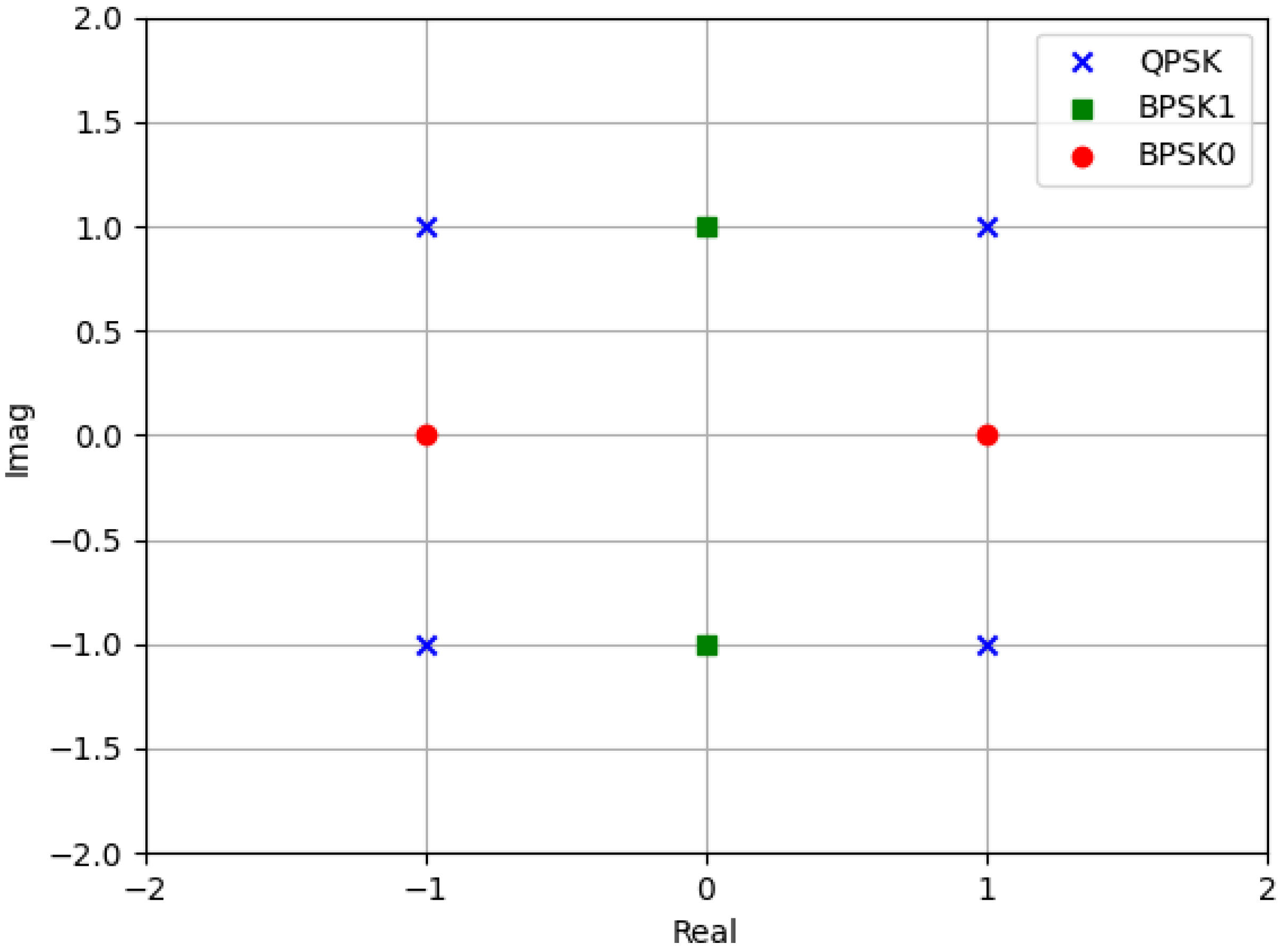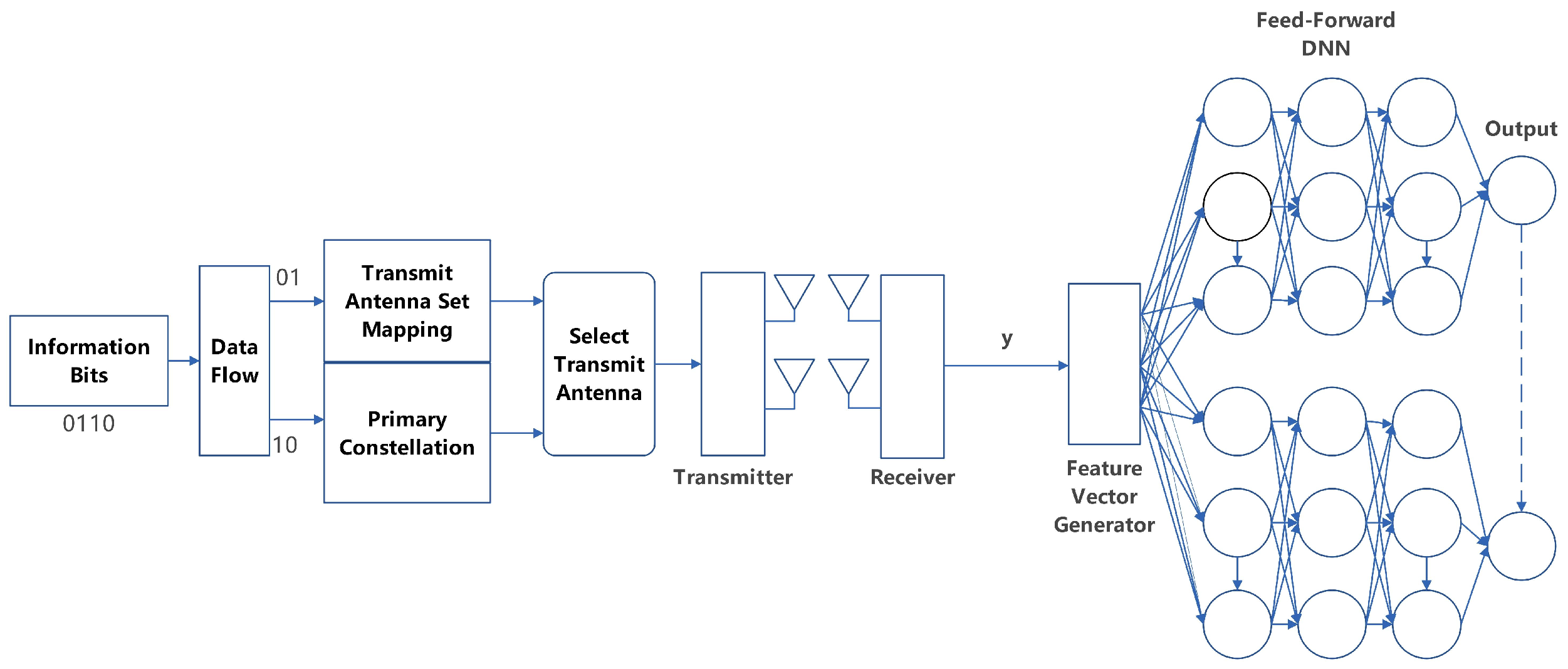Signal Detection for Enhanced Spatial Modulation-Based Communication: A Block Deep Neural Network Approach
Abstract
1. Introduction
2. ESM System Model and Conventional Detectors
2.1. MIMO System Model
2.2. ESM System Framework
2.3. Conventional Detection
2.3.1. ML Detector Scheme
2.3.2. Conventional Detect Method
3. Proposed ESM Block-DNN Detector
3.1. Data Pre-Processing
3.1.1. Raw Data
3.1.2. Feature Vector Generator
3.1.3. Expression of the Training Input
3.2. B-DNN Parameters and Training
3.3. Prediction Phase
4. Simulation Results
5. Conclusions
Author Contributions
Funding
Data Availability Statement
Acknowledgments
Conflicts of Interest
References
- Mesleh, R.; Haas, H.; Sinanovic, S.; Ahn, C.; Yun, S. Spatial modulation. IEEE Trans. Veh. Technol. 2008, 4, 2228–2241. [Google Scholar] [CrossRef]
- Cheng, C.; Sari, H.; Sezginer, S.; Su, Y.T. Enhanced Spatial Modulation With Multiple Signal Constellations. IEEE Trans. Commun. 2015, 6, 2237–2248. [Google Scholar] [CrossRef]
- Huang, H.; Guo, S.; Gui, G.; Yang, Z.; Zhang, J.; Sari, H. Deep learning for physical-layer 5G wireless techniques: Opportunities, challenges and solutions. IEEE Wirel. Commun. 2020, 1, 214–222. [Google Scholar] [CrossRef]
- Zhu, F.; Hai, H.; Jiang, X. Efficient Antenna Selection for Adaptive Enhanced Spatial Modulation: A Deep Neural Network Approach. IEEE Commun. Lett. 2023, 5, 1352–1356. [Google Scholar] [CrossRef]
- O’Shea, T.; Hoydis, J. An introduction to deep learning for the physical layer. IEEE Trans. Cognit. Commun. Netw. 2017, 4, 563–575. [Google Scholar] [CrossRef]
- Jiang, C.; Zhang, H.; Ren, Y.; Han, Z.; Chen, C.; Han, Z. Machine learning paradigms for next-generation wireless networks. IEEE Wirel. Commun. 2017, 4, 98–105. [Google Scholar] [CrossRef]
- Dorner, S.; Cammerer, J.; Hoydis, J.; Brink, S. Deep learning based communication over the air. IEEE J. Sel. Top. Signal Process. 2018, 2, 132–143. [Google Scholar] [CrossRef]
- Aoudia, A.; Hoydis, J. End-to-end learning of communications systems without a channel model. In Proceedings of the 52nd Asilomar Conference on Signals, Systems, and Computers, Pacific Grove, CA, USA, 28–31 October 2018; pp. 298–303. [Google Scholar]
- Kim, H.; Jiang, Y.; Rana, R.; Kannan, S.; Viswanath, P. Communication algorithms via deep learning. In Proceedings of the 6th International Conference on Learning Representations, Vancouver, BC, Canada, 30 April–3 May 2018; pp. 1–17. [Google Scholar]
- Pinkus, A. Kolmogorov-Arnold neural network (KAN): A deep learning approach for function approximation. IEEE Trans. Neural Netw. Learn. Syst. 2017, 9, 2134–2145. [Google Scholar]
- Pineau, J.; Paquet, S.; Precup, D. Cognitive Computing: A Roadmap for the Future. IBM J. Res. Dev. 2016, 60, 1–10. [Google Scholar]
- Alawad, A.; Hamdi, A. A Deep Learning-Based Detector for IM-MIMO-OFDM. In Proceedings of the 2021 IEEE 94th Vehicular Technology Conference, Norman, OK, USA, 27–30 September 2021; pp. 2465–2477. [Google Scholar]
- Zhang, J.; Li, Y.; Huang, W.; Guo, H.; Yuen, C.; Guan, L. DNN-Aided Message Passing Based Block Sparse Bayesian Learning for Joint User Activity Detection and Channel Estimation. In Proceedings of the 2019 IEEE VTS Asia Pacific Wireless Communications Symposium, Singapore, 28–30 August 2019; pp. 1178–1203. [Google Scholar]
- Liao, Y.; Deng, H.; Xie, Y.; Liu, J.; Yuan, B. Low-complexity Neural Network-based MIMO Detector using Permuted Diagonal Matrix. In Proceedings of the 2020 54th Asilomar Conference on Signals, Systems, and Computers, Pacific Grove, CA, USA, 1–4 November 2020; pp. 1058–1065. [Google Scholar]
- Albinsaid, H.; Singh, K.; Biswas, S.; Li, C.P.; Alouini, M.S. Block deep neural network-based signal detector for generalized spatial modulation. IEEE Commun. Lett. 2020, 12, 2775–2779. [Google Scholar] [CrossRef]
- Shamasundar, B.; Chockalingam, A. A DNN Architecture for the Detection of Generalized Spatial Modulation Signals. IEEE Commun. Lett. 2020, 12, 2770–2773. [Google Scholar] [CrossRef]
- Zhu, J.; Deng, Y. Graph Neural Network Based Signal Detection in Quadrature Spatial Modulation System. In Proceedings of the 2023 IEEE the 23rd International Conference on Communication Technology (ICCT), NJ, CN, Wuxi, China, 20–22 October 2023; pp. 216–220. [Google Scholar]
- Shu, Y.; Peng, Y.; AL-Hazemi, F. Deep Learning Based Signal Detection for Quadrature Spatial Modulation System. China Commun. 2021, 5, 1–7. [Google Scholar]
- Mao, Q.; Hu, F.; Hao, Q. Deep learning for intelligent wireless networks: A comprehensive survey. IEEE Commun. Surv. Tutor. 2018, 4, 2595–2621. [Google Scholar] [CrossRef]
- Glorot, X.; Bordes, A.; Bengio, Y. Deep sparse rectifier neural networks. In Proceedings of the 2011 14th International Conference on Artificial Intelligence and Statistics, Fort Lauderdale, FL, USA, 11–13 April 2011; pp. 315–323. [Google Scholar]






| Tx1 | Tx2 | |
|---|---|---|
| C1 | QPSK | 0 |
| C2 | 0 | QPSK |
| C3 | BPSK0 | BPSK0 |
| C4 | BPSK1 | BPSK1 |
| Tx1 | |
|---|---|
| Input nodes | 2() |
| Learning rate | 0.005 |
| Hidden layer | 3 |
| Number of training set | 15,000,000 |
| Output nodes | M |
| Number of validation set | 5,000,000 |
| Hidden layer activation | ReLu |
| Epoch | 50 |
| Output layer activation | Softmax |
| Loss function | Cross-entropy |
| QPSK hidden nodes | 256-128-64 |
| BPSK0 hidden nodes | 256-128-64 |
| BPSK1 hidden nodes | 256-128-64 |
| Optimizer | SGD |
| Detector | Real-Valued Multiply-Accumulate Operations |
|---|---|
| ESM-ML | |
| ESM-ZF | |
| ESM-MMSE | |
| ESM-DNN |
Disclaimer/Publisher’s Note: The statements, opinions and data contained in all publications are solely those of the individual author(s) and contributor(s) and not of MDPI and/or the editor(s). MDPI and/or the editor(s) disclaim responsibility for any injury to people or property resulting from any ideas, methods, instructions or products referred to in the content. |
© 2025 by the authors. Licensee MDPI, Basel, Switzerland. This article is an open access article distributed under the terms and conditions of the Creative Commons Attribution (CC BY) license (https://creativecommons.org/licenses/by/4.0/).
Share and Cite
Jin, S.; Peng, Y.; AL-Hazemi, F.; Mirza, M.M. Signal Detection for Enhanced Spatial Modulation-Based Communication: A Block Deep Neural Network Approach. Mathematics 2025, 13, 596. https://doi.org/10.3390/math13040596
Jin S, Peng Y, AL-Hazemi F, Mirza MM. Signal Detection for Enhanced Spatial Modulation-Based Communication: A Block Deep Neural Network Approach. Mathematics. 2025; 13(4):596. https://doi.org/10.3390/math13040596
Chicago/Turabian StyleJin, Shaopeng, Yuyang Peng, Fawaz AL-Hazemi, and Mohammad Meraj Mirza. 2025. "Signal Detection for Enhanced Spatial Modulation-Based Communication: A Block Deep Neural Network Approach" Mathematics 13, no. 4: 596. https://doi.org/10.3390/math13040596
APA StyleJin, S., Peng, Y., AL-Hazemi, F., & Mirza, M. M. (2025). Signal Detection for Enhanced Spatial Modulation-Based Communication: A Block Deep Neural Network Approach. Mathematics, 13(4), 596. https://doi.org/10.3390/math13040596







